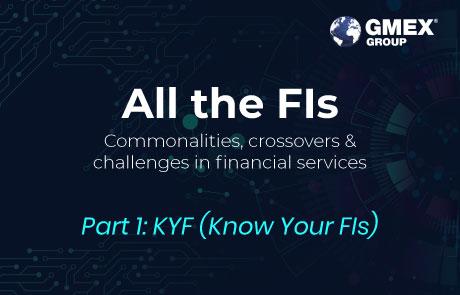All the FIs: Commonalities, crossovers and challenges in financial services
Part 1 – KYF (Know Your Fis)
There’s nothing the financial services sector likes more than creating new acronyms and abbreviations to describe its functions and services. While acronyms like ISDA, SWIFT and SIBOS have over time evolved into ‘brands’ in their own right, the plethora of three-letter acronyms (TLAs) and short form descriptors for financial services (Fi), applications (apps!) and processes can be confusing.
This is certainly true with respect to the advent of digital technologies in financial markets, and the rapid introduction of terms like DeFi, CeFi – even HyFi – into the TradFi world. But what do they all mean?
TradFi (traditional finance) financial/capital markets players and services, which are not digital.
DeFi (decentralised finance) typically refers to financial applications – dApps – built on a block chain and operating via smart contracts (software code that defines the rules of a specific DeFi protocol). The core agenda and modus operandi of DeFi was the disintermediation of traditional banks, hedge funds and venture capitalists from traditional finance (TradFi) activities such as borrowing, lending and trading assets. Nonetheless, as digital assets move towards increased regulation, the agenda has shifted somewhat to how DeFi can be regulated, with bodies such as the Financial Services Regulatory Authority (FSRA) at Abu Dhabi Global Market (ADGM) consulting industry participants on this. This offers opportunities to enable a broad range of asset classes including digital carbon credits and ESG securities.
The key difference between TradFi and DeFi, is that the former is regulated (with particular emphasis on consumer protection), while the latter is not… yet. Nonetheless, as of January 2023, it was independently estimated that the DeFi market is projected to grow from $9.4 billion in 2021 to $70.3 billion in 2027, at a compound annual growth rate (CAGR) of 39.5% during the forecast period.
But as the saying goes “with great power comes great responsibility” and DeFi has seen a number of hiccoughs and failures to date. In some cases, this is a result of ‘users’ not fully grasping the risks and responsibilities that come with such ‘empowerment’ and in others, it is simply the consequence of ill-conceived, experimental protocols, and vulnerability to hackers.
Some institutional DeFi pools have begun to emerge and these are certainly attractive to firms struggling to get their heads around tokenization and security tokens (including) tokenized carbon credits, but excited about potential yields from new forms of structured products. Institutions, investors and financial services providers want to know how they can access and integrate with new digital markets, at the same time protecting their traditional franchise.
CeFi (centralised finance) describes blockchain and DLT technologies and assets including NFTs (Non-Fungible Tokens – another TLA!), cryptocurrency exchanges and centralised lending/borrowing apps. CeFi companies are privately-owned and operate behind closed doors, in accordance with their own rules of engagement.
Recognising that there are digital technologies, assets and transactions beyond blockchain, and to support smart contracts, the US SEC has already amended its rules and definitions to describe what constitutes an exchange (beyond a matching platform).
HyFi (hybrid finance) is a term we coined (no pun intended!), and as the name suggests, describes a hybrid market infrastructure that combines elements of DeFi, TradFi (and where relevant CeFi), such as regulated and non-regulated venues and processing infrastructures, off and on-chain assets etc.
Each of the FIs has dependencies on others. For instance, DeFi’d Apps don’t generally support debit cards and bank transfers, and TradFi infrastructures have only recently begun to accommodate crypto payments (and only to a limited extent). As such, CeFi services can act as a useful bridge between these two worlds. The evolution of traditional custodians to embrace digital asset custody may also serve as another bridge connecting institutional TradFi, DeFi and digital assets (and in some cases cryptocurrencies). Companies like Invesco are already looking at common fundamentals in digital evolution and in particular, how digitally-active financial firms are managing transaction lifecycles to ensure they are compliant (for example, through custody and management of private keys to enable access to assets on a blockchain).
The challenge for TradFi is to make sure that these changes are well understood at a strategic level. All of the Fis will increasingly intermingle and interconnect, leveraging some form of layer two protocol for seamless interoperability. And this is a good thing, it gives financial markets participants greater flexibility to do what they need to do, in the way that works best for them. As an analogy, regardless of which mobile phone network individuals choose as their service provider, they still expect to be able to talk to people on other networks. It doesn’t matter how people communicate with each other, just that they are able to seamlessly.



